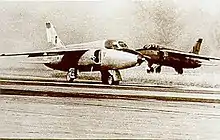Virendera Singh Pathania
Group Captain Virendera Singh Pathania was an Indian Air Force (IAF) fighter pilot reputed for making the first confirmed aerial dogfight kill[1] of independent India when he shot down a Pakistan Air Force (PAF) Sabre Jet with his Folland Gnat on 4 September, 1965. For this action, he was awarded the Vir Chakra.[2]
Virendera Singh Pathania | |
|---|---|
| Native name | Bhotti |
| Birth name | Virendera Singh Pathania |
| Nickname(s) | PAT |
| Born | 6 November 1937 Village Rey Khas, Tehsil Fatehpur, District Kangra, H.P India |
| Died | 20 February 1995 New Delhi |
| Allegiance | |
| Service/ | |
| Years of service | 37 years From 25 August 1956 to 9 December 1993 |
| Rank |  |
| Service number | 5198 F(P) |
| Unit |  No.23 Squadron Black Panther No.18 Squadron Flying Bullets |
| Battles/wars | Sino-Indian War Indo-Pakistani War of 1965 Indo-Pakistani War of 1971 |
| Awards | |
| Spouse(s) | Asha Pathania |
| Children | Trigun Pathania Karan Pathania Preeti Pathania |

On 14 December, 1971, he was awarded the Vayu Sena Medal for his role as a commander. While working under him, twenty-six-year-old flying officer PVC Nirmal Jit Singh Sekhon single-handedly engaged with six Sabre Jets. Pathania made another unconfirmed kill on 16 December, 1971, the day Gen. Niazi, Commander of the Eastern Command of the Pakistan Army surrendered to Gen. Aurora in Bangladesh.[3]
Biography
During the Sino-Indian War, the IAF was only involved in a supportive capacity. Flight Lieutenant Virendera Singh Pathania of No. 23 Squadron IAF made sorties on the perforated steel-plated Chushul airport for photo-reconnaissance.[4]
Indo-Pakistani Air War of 1965 began on 1st September 1965 after PAF dominated the skies with their F-86 and F-104 and making 4 kills of IAF Hunter planes on the very first day. However their supremacy was overshadowed when on 3rd September 1965 a Sabre was hit and a Starfigher had to leave the skies after it was attacked by Pathania who said on his radio "We shall meet again". Air Marshal Arjun Singh on that day remarked on that day's event that tyranny of PAF is over and 'Sabre slayers' were born leading Pakistani intelligence to hurriedly label Gnats as most dangerous. Amar Jit Singh Sandhu, Johnny Greene, Trevor Keelor, Virendera Singh Pathania became Sabre Slayers and were awarded Vir Chakras. [5]
During the Indo-Pakistani War of 1965, he was awarded the Vir Chakra for shooting down F-86 with his Folland Gnat jet on 4 September.[6] Pakistani officer N.M Butt of F-86 PAF ejected safely and the wreckage of Sabre Jet was recovered near Akhnoor Bridge in Jammu and Kashmir. IAF declared it as the second kill of independent India. [7] However PAF recognized 4th September 1965 as first kill by Pathania after it disputed the 3rd September kill by Trevor Keelor, for which Pakistan claimed that damaged F-86 managed to land safely and awarded Sitara-E-Jurat to the pilot Yusuf Khan who later made 1 kill in the war.
On 6 December of the Indo-Pakistani War of 1971, Squadron Leader Pathania of No. 18 Squadron IAF and Flying Officer Boppayya scrambled an incoming raid by four F-86 aircraft by intercepting their course in Srinagar.[8]
On 14 December, 1971, he was awarded the Vayu Sena Medal for his commanding lead of Air Traffic Control (ATC) while Flying Officer Nirmal Jit Singh Sekhon PVC single-handedly engaged in a suicidal dogfight with six F-86 Sabre Jet Pakistani airplanes in Srinagar while deterring attackers from their prime targets.[9]
Two days later, on 16 December, 1971, Pathania avenged the death of Flying Officer Nirmal Jit Singh Sekhon by making an unconfirmed kill of an F-86 on the day of Pakistan Army's Eastern Command's surrender, marking it as last and lone kill entry by Gnat in List of aerial victories during the Indo-Pakistani War of 1971.[10]
References
- Shukla, Ajai. "The day nothing happened". Business Standard. Retrieved 2 September 2014.
- Indian Air Force awards "Group Captain Virendera Singh Pathania". Retrieved 13 July 2021.
- David, Wg. Cdr.(Retd.) G.M. "THE LAST DOG FIGHT OVER SRINAGAR 16 DECEMBER 1971 NO 18 SQN". Retrieved 20 November 2008.
- "Importance of Chushul sector: Indian Army's consolidation will give New Delhi access to east Ladakh and region's crucial airstrip". First Post. Retrieved 16 December 2020.
- "How IAFs heroes slayer PAFs superior Sabre fighter jets". Retrieved 4 December 2021.
- "Service Record of Group Captain VS Pathania".
- "The Class of '65". Indian Express. Retrieved 29 July 2006.
- "Indian Combat Pilots". Retrieved 14 July 2021.
- "Indian Air Force Day 2020: Story Of Flying Officer Nirmal Jit Singh Sekhon". Retrieved 13 July 2021.
- "Indian Combat Pilots". Retrieved 14 July 2021.